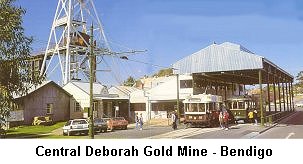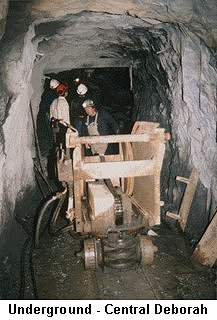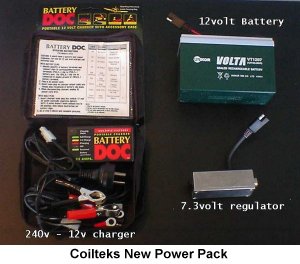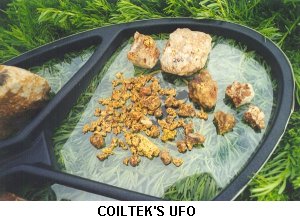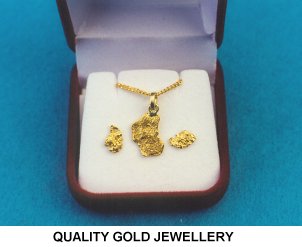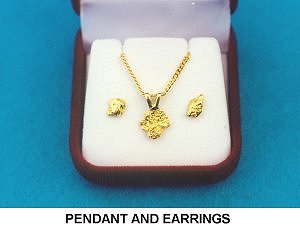
| September 2001 | |||||||||||||||
|
|||||||||||||||
Contents
|
|||||||||||||||
1. EDITORIAL On the 23rd August 2001, and EEC released its final report on the Box Ironbark Forests throughout Victoria. Gold Net Australia, along with a large number of other interested groups, including the PMAV expressed immediate concern when the initial consultants report was released. Having read this report in detail - the innacuracies - unfounded 'facts', and general thrust of the document clearly rang alarm bells throughout communities within the area, and stung organisations effected into action. It appeared clear to any reasonably intelligent person that a particular stance was being taken by the EEC which was reflected through the consultants report. Very little notice seems to have been taken by the EEC in this final report, of the countless submissions made by interested groups effected by the adopted stance.
Common sense appears to have become the first casualty in this submission.
Recently our main frame computer suffered an unwanted invasion by the SirCam virus. It totally invaded this computer and disabled many .exe files. Consequently a great deal of data was lost. Editor Email: [email protected]
All material in this magazine is copyright and may not be reproduced in any part or form whatsoever without written permission from the publisher.
|
|||||||||||||||
2. FINAL REPORT - EEC - BOX IRONBARK
 by Brad Williams Recently the EEC released the Box Ironbark Final Report. In response to this document the PMAV had provided the following summary to it's members. This summary is somewhat brief - but is to the point and is supported 'en toto' by Gold Net Australia. It is clear that this issue is far from over and the Victorian Government will be in for a torrid time if a common sense approach is not adopted. To date this has not been evident. The report to members is reproduced as provided by the PMAV. The Environment Conservation Council's Final Report for the Box and Ironbark Investigation was released to the public on Thursday, 23rd August 2001. This Report has been some 6 years in the making and has cost millions of dollars in tax payers money plus countless hours of work by voluntary organisations, including the PMAV. Around 3,500 submissions were presented to the ECC from individuals and organisations in the hope that there would be a fair and balanced outcome. PMAV members are to be congratulated on their contribution to this process. I am positive without the strong participation of the prospecting and mining industry the outcomes would have been considerably worse. Despite all this work the Report is a failure. It fails to address the main threats to biodiversity and continues to take the easy option of blaming traditional users for a claimed decrease in biodiversity without providing proof that they are doing any harm. The attached paper contains a few points that we have picked up so far in the 452 page (plus maps) Final Report. The list is by no means conclusive and we will keep you informed as time progresses. We urge you to obtain a copy of the Report for $10 plus p&p from the Department of Natural Resources and Environment phone: 136186 and read the proposed outcomes yourself. We have to convince Government that the ECC has got it seriously wrong!
We will be keeping you informed by mail as the campaign progresses and this will include what you can do to assist. For up to date information you can also access the PMAV's communities web site on: PMAV's communities web site. You can start doing your part now by contacting your local politicians and joining in the debate on all types of media. We need excellent attendance numbers at this year's Annual General Meeting. At this stage we are looking forward to two guest speakers - the Hon. Wilson Tuckey, Federal Minister for Forestry and Conservation and Hon Philip Davis, State Liberal Shadow Minister for Resources. Both should prove very interesting speakers. Wilson Tuckey is known for his strong position on sustainable use of forests and I am sure we will all be keen to hear the Liberal party's position on box ironbark from Philip Davis. Those attending the AGM will also receive the most up to date information on box ironbark plus we are hoping to organise our own celebration of 150 years of prospecting and mining in Victoria and 21 years for the PMAV. So I strongly urge you to attend. If you need assistance with transport please contact your local branch or phone 0408 176 496. In closing I thankyou for your support on all issues over the last year, you have done a fantastic job! SUMMARY
The PMAV acknowledges that there has been some attempt by the ECC to address some of the concerns raised by prospectors in their submissions to the Draft Report. For example their earlier proposal to ban raking as a prospecting tool has been withdrawn. The Reports recommendations, if adopted, would mean an 85,400 hectare decrease in state forest areas. Prospectors have generally free access to state forest areas - this right of access to 85,400 hectares, a lot of which is goldfields, is being removed. The ECC are recommending major new national parks at Heathcote/Graytown, Greater Bendigo and a national heritage park at Castlemaine. None of these were proposed in the Draft Report and therefore no member of the community has had the opportunity to comment on these recommendations.
We have lost access to the area contained in the newly proposed Heathcote/Graytown National Park. Part of this area was proposed as a state park in the Draft Report and prospecting was to be permitted but the area has been upgraded to a national park, more than doubled in size and prospecting is to be prohibited in all 12,833 hectares of it. It is recommended that prospecting be generally permitted in the newly recommended Castlemaine National Heritage Park (7,442 hectares) and the Greater Bendigo National Park (25,682 hectares). This will be subject to land manager's discretion. Prospecting is to be prohibited in the vastly expanded Chiltern-Box Ironbark National Park except for an area 100m each side of Reedy Creek. This is unacceptable. The new park covers 21,943 hectares. The report fails to acknowledge or consider the importance of this area to both gold prospectors and gem fossickers. There is some confusion in the Recommendations - in some parts prospecting is to be permitted within designated zones within parks and others is to be permitted outside designated zones. This obviously needs to move to a standard position - the PMAV has always believed that prospecting should only be excluded from areas of particular sensitivity and therefore believe that this would be the most sensible way to manage prospecting in parks. We acknowledge that there has been an attempt towards improving the 'land manager's discretion' provisions. We are pleased that the PMAV is to be consulted on guidelines for prospecting (R43). The PMAV must also be involved in the development of the process required for the exercise of land manager's discretion (R9). The ECC repeatedly mention the $2 million per year 'non-use' value given to the biodiversity 'value' of the parks and reserves. This is monetary value given to the warm and fuzzy feeling people across the state apparently have from knowing that Victoria's park and reserve system exists. The ECC have not given any monetary value to the 'non-use' value that a huge number of Victorians receive from knowing that they retain the opportunity to participate in traditionally Australian activities such as prospecting, dog walking etc. If the non-use value is to be used on one side of the balance sheet it must be used on the other. Without the imaginary $2 million 'non-use' value for biodiversity there are significant real economic losses to the people of both the region and Victoria as a whole - Government must consider this prior to making any decisions. The consultant who prepared the 'social and economic impact assessment' for the ECC acknowledged that the main beneficiaries of the $2 million 'non-use' value would be the more affluent members of society who do not generally live in the study area. This is another case of the city 'benefiting' at the cost of regional and rural Victoria. The Recommendations would put traditional forest users out of work all for the sake of people in Melbourne getting warm and fuzzy feelings knowing that parks and reserves exist in central Victoria - even if they never visit them. We think someone has lost the plot! We still question the claim that the creation of these new parks will increase tourism. A claimed $970,000 increase in tourism expenditure is projected. Parks Victoria's visitor numbers indicate a drop in visitors to all current box ironbark parks over the past two years. Many prospectors own dogs. Dogs are not allowed in national parks or nature conservation reserves. The creation of NCR's over areas such as Wedderburn (6,300 hectares), Waanyarra (2,927 hectares), Caralulup near Talbot (1,400 hectares), Havelock (1,779 hectares) etc.etc. will have considerable impact on dog owning prospectors and therefore the local economy. Dogs will not be permitted in the Greater Bendigo National Park (25,682 hectares) and we are seeking clarification regarding dogs in the (7,442 hectares) Castlemaine National Heritage Park.
Camping within nature conservation areas is expected to be very limited. Probably only in designated, and no doubt, small areas. This will have major implications to prospecting club activities. The consultant who prepared the social and economic assessment for the Report recommended that current restrictions on prospecting in parks, ie the areas that have been excluded by land manager's discretion, be reviewed. This recommendation has not been adopted by Council. The PMAV believes that this is a major omission. The PMAV has various questions regarding the enforceability of the recommendations and the costs involved of adequate management. We believe that the $400,000 estimated for additional management of the new parks and reserves will not be anywhere near enough. We will be seeking an explanation regarding why a visitor to a state forest spends $5 per day and yet that same visitor to the same area, when the label is changed to a park or reserve, spends $12 per day. This is part of the basis for claimed increase in tourism value for areas that become parks and reserves. All the mistakes in the ECC's Draft Report regarding tourism projections, timber production, gold production, job losses, extent of forest remaining, etc. have barely been acknowledged by the ECC neither have all the people and groups who put in submissions based on the Draft Report's incorrect information been told about the Report's errors.
The ECC have failed to give sufficient consideration to the real threat to biodiversity ie. the threat posed by pest plants and animals. The Report is based on ideology rather than science and we urge you to obtain your own copy to form your own opinions. Your favourite prospecting area may be affected! Let us, and your politicians, know your thoughts.
The following points are specific to mining activities.
There have been minor changes to the procedures relating to requirements to prove the economic significance of a project - this is only slightly better than the Draft.
The PMAV believes that a land swap should only be required when the land cannot be satisfactorily rehabilitated, such as when open pits are left. It is inequitable for small-miners, who always rehabilitate their sites, to be treated the same way as larger companies who are permitted to leave huge holes open. The original intention of the land swap was that it only be for areas where rehabilitation was not possible.
Small miners generally work areas that have been degraded by past mining operations and the environment is actually improved by mining operations and subsequent rehabilitation. Small miners are the small business sector of the mining industry. The Prime Minister often refers to small business as the 'engine room of the Australian economy'. Obviously there should be encouragement of this sector to grow - the ECC's recommendations would see the death of Victoria's small-scale mining industry. The consultant who prepared the social and economic survey suggested that a 'prospector's licence' should be introduced as an opportunity for smaller operators to explore an area prior to applying for a full mining licence. This suggestion was not adopted by the ECC. The ECC have recommended that mining and exploration be allowed in the Greater Bendigo National Park, the Castlemaine National Heritage Park and the Deep Lead Nature Conservation Reserve - but only at a depth of 100 metres or greater - this will obviously be of no use to small miners! All small miners will have to battle extremely hard to retain the existence of their industry.
|
|||||||||||||||
|
|||||||||||||||
3. THE CENTRAL DEBORAH'S HERITAGE by Sue "Goldie" Reynolds
Bendigo is a wonderful place to visit. Located in Central Victoria, this cosmopolitan city is an outstanding example of a large rural city. The gold that did come from the deep mines of Bendigo was prolific. No less than 10 times the gold that Ballarat gave to the world. Most of this gold was from the deep mines of Bendigo and not on or near the surface.
One of these deep mines was the Central Deborah Gold Mine.
Today Bendigo has accumulated 34 Vintage Trams, which are housed in a complex that was built in 1901-1903. Each of these trams are operational and all regularly use the tram tracks - starting at the Central Deborah Gold Mine, and traversing the old world charm of the Central Business District, which has an outstanding array of grand old buildings. The Caf� Tram is of 1952 vintage and gently rolls along the main thoroughfare through Bendigo. Travel in air-conditioned comfort and enjoy the outstanding cuisine for a maximum of 34 people. Bookings are essential for this service. The Central Deborah Mine had a colourful history and although it produced more than a ton of gold in it's lifetime - was never a resounding success financially for its operators. What is one of the great adventures at the Central Deborah - is that incredible labyrinth of tunnels that criss cross underground to incredible depths. In fact - most of the mine tunnels are now filled with water - but travelling down 20 levels one can experience the excitement of a great underground adventure. Climb down ladders - walk along long tunnels and fossick for gold as you progress. This is a fabulous tour and a great adventure for all to enjoy - young and old.
However once underground, the feeling of being so far from the surface is not a consideration as you become engrossed in the history and events that are before you. Gold protruding from the side of shafts is plainly evident. It is really exciting to be walking along and come across gold that is still there lodged in the quartz. As you progress you often find real miners mining for gold in selected pockets. The tour guides are well informed - well trained and certainly safety conscious. In fact they are highly safety conscious, which is a good thing to see today. At the conclusion of the tour you are treated to a decent feed in the old miners dining room way way underground. The staff at the Central Deborah are a friendly bunch of country folk who really enjoy and encourage the friendly atmosphere, that exudes from the facility. I can thoroughly recommend a visit to this great mine as a rewarding experience you will remember for a long time. Prices are as follows: The Welcome Stranger Pass - includes
Underground Mine Tour and Vintage Tram Tour. Entry to the Golden Dragon Museum, the Bendigo Art Gallery, Discovery Science & Technology Centre, and Bendigo Pottery - who offer a 10% discount on pottery.
|
|||||||||||||||
|
|||||||||||||||
4. POWERING UP by Laurelle Murphy
Coiltek have a history of aggressive R & D. In recent months they have been testing power systems to improve and enhance performance. "Testing in house over the last 6 months has led us to find 3 worrying facts about the SD range of detectors in particular the shortcomings of the factory supplied 6Volt power system:
The size of the Transmit field created is exactly proportional to the Voltage supplied. Supplied in the 7.3 Volt regulated Power Kit is the following parts.
7.3-volt regulator box.
We can also provide an inverter, which takes12 volts from your car battery and converts it to 240 volts for charging your battery in the field. DO'S AND DONT'S ABOUT THIS SYSTEM
DO'S:We also include this letter from a happy customer
"Thought I'd just send you a couple of pics of a 32 oz specimen with 24 oz of gold in it found Maryborough area last month (July 2001). Just purchased your 12 volt conversion for 2200. I was detecting
an area where I had found quite a few small nuggets in the past.
That 12 volt system on the 2200D in combination with the 18" coil is dynamite. Regards ************* (a happy customer) Maryborough
|
|||||||||||||||
|
|||||||||||||||
|
5. TIPS ON USING THE UFO  by Jim Foster
While the UFO is more stable than any previous large monoloop it can still be difficult to use on very highly mineralised ground. If the ground is too much for the UFO 1 use the eighteen inch double D coil.
Pin-pointing has to be done from at least two angles to triangulate the target and prevent digging in the wrong spot. If using a SD2100 all targets that sound promising should be dug out until the signal either becomes fainter, in which case it will usually be only be hot ground, or until it becomes louder, in which case it will usually be a metal target.
I should point out here that in my experience an SD2200D will not tune out a metal target in Tracking Mode when fitted with any double D coil.
When you are close just dab the tip at the target until it actually touches it, in this way you only need to pick up a very small amount of soil with the target. Although the UFO is very light for its size it can be hard work to use all day. To overcome fatigue when using either the 24" UFO ,or the 18" Double D coil I use an Easyswing Arm fitted to mySD2200D. The UFO is an amazingly versatile coil that I am still learning about. It is no doubt the best monoloop I have used and paid for itself many times over in a very short time. It also compliments the other coils in my coil box. By ensuring that I have the best range of coils available I am assured of finding gold under almost any conditions, and importantly I now have the ability to find those bigger nuggets hiding down deeper than anyone else has yet detected. And nothing beats digging a deep hole in new ground confident that the deeper the hole the bigger the nugget is going to be. I wouldn't swap that feeling, or my UFO, for anything. WARNING When using a UFO you will be digging some very big holes, please fill these holes in when finished.
|
|||||||||||||||
|
|||||||||||||||
6. GOLD NUGGET JEWELLERY by Brad Williams
Those of us who do venture into the wilds of the gold fields and are lucky enough to find a decent nugget or two often look to enhance the value before selling it. Firstly finding a quality nugget that is suitable as a jewellery piece is the most important step. Not all nuggets that come from the ground are shaped in a manner that will allow the nugget to be used in jewellery. Preferably the nugget needs to display some flat qualities when using as jewellery pieces. Primarily so the nugget lays flat on the chest when worn on a pendant. Usually the nugget needs to have a triangular shape that allows a bail to be welded to the apex of the nugget to enable attachment to a chain.
When you have selected the gold that is suitable for jewellery, the first step in the process is to clean the gold properly.
There are many pickling solutions available from recognised suppliers - such as Twin Plaza Metals etc. in Melbourne and Adelaide. It is at this time that all should be placed on a neutral background and selections made to couple up earrings and pendants, in matching groups. Not all will match. If they don't you are best not to present them as matched. Remember the consumer is very astute in most instances. Attaching a bail to the gold nugget is a delicate operation and requires a good deal of practice to ensure the connection is sound yet retains an attractive appearance. Welding a bail to a gold nugget - requires some tools. Among them a small gas heating torch. These are available from Dick Smith Stores. Additionally a small holding device, also available from Dick Smith Stores is required to hold the nugget and the bail in place.
Once the bail has been attached to the nugget let it cool naturally. This ensures that a good weld is maintained - without stressing the weld unnecessarily. When attaching rigid gold wire to an earring it is important that the weld has no sharp projections. The weld needs to be very smooth, perpendicular and as flat as possible to ensure it fits comfortably against the ear, and is there fore very comfortable. Presentation of this jewellery is the next step in the sale process. Packaging can always cost the least but can have the most impact with the consumer. From my experience jewellery is best presented in a small black textured box. These are available in a variety of shapes and sizes and are generally used by commercial jewellers. Marketing the final product is of course the most important link in the chain from the gold find in the ground to the consumer ready article. My experience is that selling through recognised outlets is very difficult - so usually flea markets and the like are the best methods of selling your final product to the public. Making gold jewellery is a wonderful way to enhance the value of your gold. There are many who will guide and assist you in making your gold jewellery and there are also TAFE courses that teach basic jewellery procedures.
|
|||||||||||||||
|
|||||||||||||||
7. FLECKS ! - Glints from here and there
|
|||||||||||||||
|
The events of the last few days in the United States of America - have "stopped" and horrified the civilised world. It has had a deep and profound effect on all of us.
The search for words to describe the depth of feelings and emotions - an impossible task.
Terrorist attacks on all civilised societies are to be deplored. The wanton destruction of so many innocent lives - indefensible. From Australia alone - it is believed that over 90 souls lay beneath the rubble of the World Trade Centre. In all corners of the earth - there are families grieving. In China - Canada - United Kingdom - Russia and many other nations.
The united condemnation of almost ALL governments world wide - has galvanised the resolve to rid the world of this "new enemy" to civilized society. In the times of uncertainly ahead - we look to our leaders to show strength and resolve, to bring those to justice who would destroy our way of life. We express our Deepest Sympathy to the families and friends of all those who lost their lives.
|
|||||||||||||||
|
|||||||||||||||
8. STRIKES Recent Finds
|
|||||||||||||||
|
|||||||||||||||
|
9. THE NEW LODE - Next Month's Issue
|
|||||||||||||||
|
|||||||||||||||

